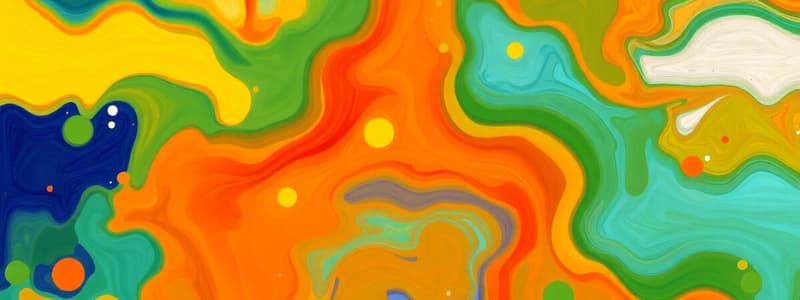Podcast
Questions and Answers
Why is proper selection of humidity measurement instruments crucial?
Why is proper selection of humidity measurement instruments crucial?
- To ensure the instruments are visually appealing.
- To simplify the data recording procedures.
- To obtain accurate and reliable results in various applications. (correct)
- To reduce the cost of maintenance.
What is the effect on relative humidity if the temperature increases, assuming the amount of moisture in the air stays constant?
What is the effect on relative humidity if the temperature increases, assuming the amount of moisture in the air stays constant?
- Relative humidity remains constant.
- Relative humidity decreases. (correct)
- Relative humidity increases.
- Relative humidity fluctuates erratically.
What is the most important reason for calibrating hygrometers?
What is the most important reason for calibrating hygrometers?
- To increase the instrument's resale value.
- To make the instrument look new.
- To ensure accurate humidity measurements by accounting for sensor drift. (correct)
- To simplify the measurement process.
Which of the following is a consideration for setting up humidity measurements?
Which of the following is a consideration for setting up humidity measurements?
What is absolute humidity?
What is absolute humidity?
If a room humidity monitoring system requires minimal intervention and the data doesn't need to be consulted in real-time, what is a viable solution?
If a room humidity monitoring system requires minimal intervention and the data doesn't need to be consulted in real-time, what is a viable solution?
In what applications is humidity monitoring crucial?
In what applications is humidity monitoring crucial?
When measuring humidity at high temperatures, what primary concern should be addressed?
When measuring humidity at high temperatures, what primary concern should be addressed?
In a compressed air supply line, why is a dew-point capacitive probe often used, and what feature is commonly included to protect the sensor?
In a compressed air supply line, why is a dew-point capacitive probe often used, and what feature is commonly included to protect the sensor?
Why is it important to consider the potential for condensation when using relative humidity probes at high temperatures?
Why is it important to consider the potential for condensation when using relative humidity probes at high temperatures?
What should be done if a hygrometer has been exposed to extreme conditions?
What should be done if a hygrometer has been exposed to extreme conditions?
Why is careful setup and maintenance particularly important for wet- and dry-bulb hygrometers (psychrometers) used in climatic test chambers?
Why is careful setup and maintenance particularly important for wet- and dry-bulb hygrometers (psychrometers) used in climatic test chambers?
What is the importance of allowing time for a humidity reading to stabilize, especially for dry gases?
What is the importance of allowing time for a humidity reading to stabilize, especially for dry gases?
What action should NOT be taken when working with humidity sensors?
What action should NOT be taken when working with humidity sensors?
What is the potential impact of pressure differences on humidity measurements?
What is the potential impact of pressure differences on humidity measurements?
What issue is commonly associated with older hygrometers?
What issue is commonly associated with older hygrometers?
What should be checked as a troubleshooting step if a hygrometer is providing incorrect readings?
What should be checked as a troubleshooting step if a hygrometer is providing incorrect readings?
Why is it important to record humidity measurement results with care?
Why is it important to record humidity measurement results with care?
When measuring humidity using a psychrometer, a dry-bulb temperature of 24°C and a wet-bulb temperature of 17°C are recorded. Using the provided chart excerpt, what is the relative humidity?
When measuring humidity using a psychrometer, a dry-bulb temperature of 24°C and a wet-bulb temperature of 17°C are recorded. Using the provided chart excerpt, what is the relative humidity?
A sling psychrometer measures a dry bulb temperature of $T = 29.4$ °C and a dew point of $T_d = 18.3$ °C . The relative humidity is defined by $rh = E/E_s$ where E is the 'actual' vapor pressure and $E_s$ is the 'saturation' vapor pressure. What is the relative humidity?
A sling psychrometer measures a dry bulb temperature of $T = 29.4$ °C and a dew point of $T_d = 18.3$ °C . The relative humidity is defined by $rh = E/E_s$ where E is the 'actual' vapor pressure and $E_s$ is the 'saturation' vapor pressure. What is the relative humidity?
According to the formula: $T_d = T - \frac{100 - RH}{5}$, what does $T_d$ represent?
According to the formula: $T_d = T - \frac{100 - RH}{5}$, what does $T_d$ represent?
According to the formula: $T_d = T - \frac{100 - RH}{5}$, if the Air Temperature (T) is 25°C and the Relative Humidity (RH) is 60%, what is the Dew Point ($T_d$)?
According to the formula: $T_d = T - \frac{100 - RH}{5}$, if the Air Temperature (T) is 25°C and the Relative Humidity (RH) is 60%, what is the Dew Point ($T_d$)?
According to weather reports there is 54% humidity. Which of the following answers regarding this measurement is correct?
According to weather reports there is 54% humidity. Which of the following answers regarding this measurement is correct?
Which of the following describes a situation where a 'data logger' would be a viable solution?
Which of the following describes a situation where a 'data logger' would be a viable solution?
Which of the following statements is true?
Which of the following statements is true?
What is 'Saturation Vapour Pressure (SVP)'?
What is 'Saturation Vapour Pressure (SVP)'?
Given an environment, what are the things that could be considered to select the correct instrument to measure humidity?
Given an environment, what are the things that could be considered to select the correct instrument to measure humidity?
Why is humidity important?
Why is humidity important?
What are other important humidity concepts?
What are other important humidity concepts?
Which of the following is a way to quantify humidity?
Which of the following is a way to quantify humidity?
What is a Hygrometer?
What is a Hygrometer?
Which of the following steps should be taken in the event of 'Troubleshooting Hygrometer Readings'?
Which of the following steps should be taken in the event of 'Troubleshooting Hygrometer Readings'?
What parameters are measured with a Psychrometer?
What parameters are measured with a Psychrometer?
What is the defining characteristic of 'relative' humidity?
What is the defining characteristic of 'relative' humidity?
How is 'absolute' humidity typically expressed?
How is 'absolute' humidity typically expressed?
What are the factors that can cause readings of humidity instrument to be uncertain (incorrect)?
What are the factors that can cause readings of humidity instrument to be uncertain (incorrect)?
Which of the following is an example of when humidity measurements are in used?
Which of the following is an example of when humidity measurements are in used?
What is a 'Dew-point Hygrometer'?
What is a 'Dew-point Hygrometer'?
What is the meaning of the reading 'Knots 6.7' on an instrument that measures humidity?
What is the meaning of the reading 'Knots 6.7' on an instrument that measures humidity?
What is 'Specific Humidity'?
What is 'Specific Humidity'?
Flashcards
What is Relative Humidity (RH)?
What is Relative Humidity (RH)?
Indicates the actual water content of air as a percentage of the maximum amount it could possibly hold.
What is humidity?
What is humidity?
A measure of water vapor in the air.
What is Absolute Humidity?
What is Absolute Humidity?
Describes the actual amount of water vapor in the air in g/m3 regardless of temperature.
What is a Hygrometer?
What is a Hygrometer?
Signup and view all the flashcards
Why is humidity measurement important?
Why is humidity measurement important?
Signup and view all the flashcards
What sensors are used in climatic test chambers?
What sensors are used in climatic test chambers?
Signup and view all the flashcards
Why is Calibration Important?
Why is Calibration Important?
Signup and view all the flashcards
Uncertainty of Measurement
Uncertainty of Measurement
Signup and view all the flashcards
What to watch out for when measuring
What to watch out for when measuring
Signup and view all the flashcards
Troubleshooting Incorrect Readings
Troubleshooting Incorrect Readings
Signup and view all the flashcards
Special Cases with Gases
Special Cases with Gases
Signup and view all the flashcards
What does Humidity Mean?
What does Humidity Mean?
Signup and view all the flashcards
Absolute Humidity
Absolute Humidity
Signup and view all the flashcards
Relative Humidity
Relative Humidity
Signup and view all the flashcards
Specific Humidity
Specific Humidity
Signup and view all the flashcards
Why Calculate Humidity?
Why Calculate Humidity?
Signup and view all the flashcards
The Dew Point
The Dew Point
Signup and view all the flashcards
Signup and view all the flashcards
Study Notes
- Humidity is a measure of water vapor in the air.
- Meteorologists use different ways to describe water vapor in the atmosphere.
Absolute Humidity
- Describes the actual amount of water vapor in the air.
- It is measured in grams per cubic meter (g/m3).
- Measurement is regardless of the temperature.
Relative Humidity (RH)
- Indicates the actual water content of air.
- Air content is expressed as a percentage of the maximum amount it could possibly hold.
Relative Humidity vs Absolute Humidity
- Absolute humidity commonly refers to the actual amount of water vapor present in the air.
- Relative humidity is a percentage of the amount of moisture the air could possibly hold.
- Absolute humidity is expressed in moisture per cubic meter of air (g/m³).
- Relative humidity is expressed in percentage as the ratio of vapor pressure to saturated vapor pressure.
- Absolute humidity is independent of the temperature.
- When temperature goes up, relative humidity goes down and vice-versa.
Why Humidity Is Important
- Crucial for human health and comfort
- Important for animal health
- Plays a role in weather and climate
- Critical for industrial and manufacturing processes
- Significant for agriculture and plant growth
Qualities of Water Vapour
- Water vapour is invisible and behaves like a gas, condenses into water or gas.
- It reacts with surfaces and penetrates materials.
- A gas's ability to hold water vapour increases with temperature.
How to Quantify Humidity
- Relative Humidity
- Dew Point
- Fraction or Ratio
- Concentration
Other Important Humidity Concepts
- Saturation
- Partial Pressure
- Saturation Vapour Pressure (SVP)
- Supercooled Water
Hygrometer
- It is an instrument used for measuring the moisture content in the atmosphere.
Hygrometer Types
- Mechanical Hygrometer
- Electrical Hygrometer
- Dew-Point Hygrometer
- Psychrometer
Humidity Measurement
- It is an essential aspect of various industrial, scientific, and environmental applications.
- Selecting an appropriate instrument and ensuring proper measurement techniques are crucial for obtaining accurate and reliable results.
- Considerations for their use, sampling methods, and data recording procedures are essential.
Selection of Instruments
- The instrument has to have the correct measurement type, operating conditions, instrument performance.
- You have to configure the instrument correctly, and then consider power-supply and data output.
- Also, consider alarm and control features, environmental factors, safety and robustness, cost and maintenance, and user considerations.
Additional Instrument Considerations
- Operating Procedures
- Maintenance
- Calibration
- Interim Checks
Measurement Set-Up and Sampling
- Consider configuration, avoiding sample contamination, preventing condensation and measuring dry gases.
- Ensure there is a pump placement, temperature consideration and repeated readings.
Recording Humidity Measurement Results
- Data Logging
- Manual Recording
- Comprehensive Documentation
Humidity Measurement Examples
- Humidity measurement plays a crucial role in various industrial and environmental applications.
- Different settings require specific instruments and methods to ensure accurate and reliable monitoring.
Room Humidity Monitoring
- Aim for a long-term record of temperature and humidity in a moderate range.
- Consider unsupervised operation, whether data at intervals are enough e.g. hourly, real-time information needed, or record to view later.
- A possible solution is Automated "data logger".
- It can download reading easily to a computer.
Industrial Oven
- Humidity is measured at high temperatures to show progress of heat treatment such as drying or baking.
- Consider whether there will be dust, or other vapours apart from water.
- One solution is using relative humidity probes specified for high temperatures.
- Can extract a sample flow of gas to a cooler temperature (avoiding condensation).
- Check sensitivity to any chemicals given off during heating.
Compressed Air Supply Line
- Monitor air supply inside a pipeline to confirm level of dryness is a requirement.
- Consider any level of dust or oil in the gas stream.
- Consider if there is unsupervised use, remote reading and alarms needed.
- One solution is use a dew-point capacitive probe because the sensor usually has a sintered filter.
- Upstream filtering of the gas flow helps protect the sensor.
- Dew-point probes vary in their speed of response and long-term performance.
Climatic Test Chamber
- Has a range of temperatures and humidities.
- Rapid changes may need tracked.
- Condensation might occur at times (depending on the test performed).
- Consider response time, the robustness of instrument at hot and wet extremes and the actual planned range of test conditions.
- Possible solution: relative humidity sensors (probes) are designed to cope with a wide humidity and temperature range.
- Wet- and dry-bulb hygrometers (psychrometers) can be suitable, although they need careful setting up and maintenance.
Calibration
- Calibration is essential for accurate humidity measurement.
- Hygrometers (humidity measuring devices) do not always give exact readings.
- This is because of long-term drift due to sensor aging.
- Calibration tells you how much error is present.
- Calibration does not necessarily fix the instrument.
How is Calibration Done?
- A hygrometer is compared to a reference instrument in a controlled environment.
- The reference instrument needs to be calibrated and traceable to a standard.
- Done in laboratories or using field methods like salt solutions.
Uncertainty of Measurement
- All measurements have some level of uncertainty, meaning the actual value might be slightly different.
- Common causes of uncertainty consist of instrument issues, and environmental factors.
- Instrument issues are sensor drift, noise, and limited resolution.
- Environmental factors are temperature changes and unstable conditions.
- The level of confidence associated with the uncertainties is 95%.
- Normal uncertainty in ideal conditions: ±2% RH to ±3% RH
- Normal uncertainty in difficult conditions: ±5% RH to ±10% RH or worse.
- The best dew-point hygrometers in labs can achieve uncertainty as low as ±0.05 to ±0.1.
Humidity Measurement Dos and Don'ts
- Make use of the manual, and of manufacturer's advice
- Have the instrument calibrated, and take account of any calibration corrections required
- Let the instrument reach the temperature of the location
- Allow time for the humidity reading to stabilise (especially for dry gases)
- Record measurement results with suitable care
- Be clear when expressing humidity differences
- Check any hygrometer that has been exposed to extreme conditions or contaminants.
- Don't handle humidity sensors roughly, and don't abuse well-mounted sensors
- Don't use sensors outside the temperature or humidity range specified by the manufacturer – this could cause a shift in calibration.
- Don't expose sensors to condensation – unless they can definitely tolerate this
- Don't mix and match humidity probes with different electronics units.
- Unless they are definitely designed for this, instrument suppliers can advise if a probe is a “self-contained" interchangeable unit with its own signal processing inside
Watch Out For:
- Droplets, or stray water in any form. If present, humidity measurements may be misleading.
- Dust – impacts most instrument types.
- Watch pressure differences (dew point) or temperature differences (relative humidity).
Troubleshooting Incorrect Hygrometer Readings:
- Make sure all equipment is switched on and all cables are connected
- Consider whether the hygrometer and the conditions have had long enough to stabilise
- Check that the temperature is as expected (particularly for relative humidity measurement).
- Check the most recent calibration certificate and comparing against another hygrometer can help confirm a correct reading.
- Beware of human error mistakes in recording, mis-reading, wrongly numbering sets of sensors.
Special Cases of Humidity Measurement
- Consider the temperature change if measuring gas at one temperature and using it at another because measured values may need converted or interpreted
- Also consider the pressure change if measuring at gas at one pressure and using it at another because measured values may need to be converted or interpreted.
- In-vacuum Humidity measurements can be made below atmospheric pressure, requiring careful setup and interpretation.
- In non-air gases, select a humidity is measured like fuel ("natural gas") and various process gases by choosing a measurement method suitable for the particular gas.
- In harsh environments dust, vibration, condensation, airborne droplets, chemicals all pose challenges to most hygrometers.
- In older hygrometers modern electronic humidity sensors have increasingly long lifespans, if treated well.
Humidity Calculation
- Humidity is the amount of water vapor present in the air.
- Absolute humidity is the mass of water vapor in a given volume of air, typically measured in grams per cubic meter (g/m³).
- Relative humidity is the percentage of water vapor in the air compared to the maximum it can hold at a specific temperature.
- Specific humidity is the ratio of the mass of water vapor to the total mass of air, often expressed in grams of water vapor per kilogram of air (g/kg).
Why Calculate Humidity?
- Human Comfort and Health
- Weather Prediction and Climate Control
- Industrial and Agricultural Applications
- Preventing Mold and Damage to Materials
- HVAC and Energy Efficiency
Studying That Suits You
Use AI to generate personalized quizzes and flashcards to suit your learning preferences.




